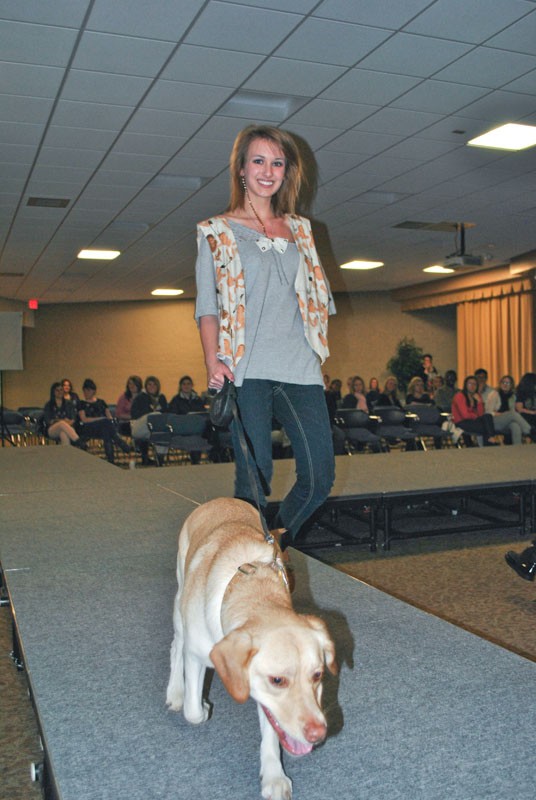Students dress up to end animal cruelty

GVL / Allison Young Compassion in Fashion was a show to help promote the GV Humane Society
Jan 16, 2012
Students filled Grand Valley State University’s Grand River Room, some fashionably dressed, as models prepared to take the stage — photographers on hand to record every composition — and a dog barks in the background.
Although two very different clubs, the Humane Society of Grand Valley and the GV Fashion Club came together Saturday for the second-annual Compassion in Fashion event, which raised $344 for the West Michigan Critter Haven and the Kent County Animal Shelter this year.
The show featured a cat walk where student models showed off their non-animal sourced clothing and accessories found at local businesses such as Closet Case Resale, Clothing Matters and One Girl’s Treasure, as well as original pieces created by members of the GV Fashion Club. Clothing modeled ranged from casual to formal, classic to unique.
As each model walked the runway, attendants were given fashion tips from the models and told how they were connected to animals, with everyone from pet owners to animal lovers represented.
Info tables were also present including a fur testing station and tables for nonprofit Coats for Cubs, Humane Shopper Station, Humane Society of GV, Western Michigan Critter Haven and Meatless Mondays.
The Michigan State Director for Humane Society of the United States, Jill Fritz, also spoke about the work, values and goals of the Humane Society of the U.S. Fritz focused mainly on animal testing.
To ensure that they are safe for humans, many products are tested on animals for what is called an “end-point,” which tests products for potential side-effects that may involve eye and skin irritation, birth defects, carcinogens and more.
In addition to an end-point test, many companies also practice what’s called the LD50 test, or lethal dose 50 percent. This test looks for the dosage of toxins, radiation or pathogen that can kill half of the animals tested. During LD50 tests, animals are forced to eat, inhale, absorb or be injected with the product.
For albino rabbits, docile animals with low cost, companies immobilize the rabbits for sometimes up to 14 days, to test products in their eyes.
And though hazardous to the animals, Fritz said this is still an inaccurate test due to the dissimilarities between rabbit and human eyes.
A skin test is also employed where animals are shaved and layers of their skin are removed. The chemical or mixture is then placed on the exposed skin and covered with gauze.
However, as animal testing practices became more well-known, companies began to change. Public outrage led to laws banning animal testing. In the U.S., California was the first to pass a law against animal testing followed by New Jersey and New York in 2007 and 2008.
To help stray away from supporting animal tested products, students were informed that products marked cruelty free or that have a bunny on them show that the product was not tested on animals; however, this does not always guarantee no animal testing in every stage of making the product or with individual ingredients, Fritz said.
Fritz said people need to learn more about animal cruelty, learn alternatives to animal testing and spread the word. “It is such a simple act to buy cruelty-free products and there is no reason for us to wait to make a difference,” said Alexis Croswell, president of HSGV. “It’s not about making radical changes or going ‘cold turkey’ but it is about being conscious enough in our daily decisions that we are able to make improvements.”
More information on cruelty-free products can be found on www.leapingbunny.org, where companies proven to be free of animal testing are listed.

























